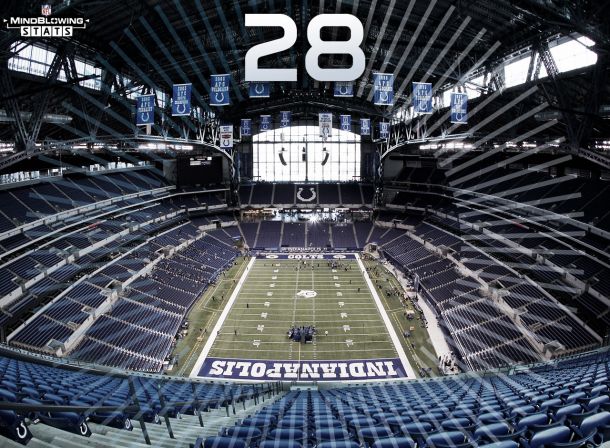This weekend the NFL holds its annual scouting combine in Indianapolis. This is the time when draftniks hunker down for the meat market.Draft eligible players are weighed, measured, poked and prodded before being asked to perform light drills and feats of supposed athletic evaluation in what some refer to, derisively, as the “underwear Olympics”. The stories of players who have made their draft status by outstanding performances at the combine are well known throughout the world of draft picks as well as more casual fans. You will no doubt hear reference to players such as Mike Mamula, the ultimate “workout warrior” who inflated his draft stock back in the ‘90s. This writer would bet his eye teeth that you will also reference to Maurice Clarett’s horrific performance at the event in 2003.
Fans will be told that a player’s draft status-his football future- could come down to how fast he covers 40 yards in Indianapolis or how long his arms measure or whether he is three quarters of an inch taller or shorter than his college claimed he was. Comparisons to past players will be rampant as well, already we can find information on the hand size of top quarterback prospects Johnny Manziel, Blake Bortles, and Teddy Bridgewater as compared to Russell Wilson, who now apparently has the optimum hand size since he quarterbacked the Super Bowl champions. For every player who makes a name for himself at the combines, such as Stephen Paea did a few years ago with a record number of reps on the bench press, there are others who harm their draft status with a disastrous performance, such as Vontaze Burfict did a couple of years ago. The problem, of course, is in the interpretation of what information we receive and/or have confirmed as a result of the combines. Burfict, as fans now know, did indeed go undrafted largely because of his unimpressive performance in meeting with teams at the combine and thereafter, but has become one of the better young linebackers in the NFL with the Cincinnati Bengals.
All the consternation that came out of the combines when superstar Florida linebacker Brandon Spikes ran a 40 so slow it could’ve been timed with a sundial has likewise been misplaced as Spikes is another upper level defensive player in the NFL. The converse is true as well. Remember when USC star Taylor Mays ran a 40 so fast that it was literally equivalent to world class Olympic sprint speed? Nothing against Mays, but running a 40 time faster than almost any other defensive back- especially when you’re 6’3 220 pounds- doesn’t necessarily transcend into being an elite safety in the NFL. It’s important not to lose sight of the important information coming out of the combines. If your favorite team needs an offensive linemen, whether or not the prospect can do 28 or 30 reps on the bench is not what you should be worried about. The real issue is a player’s preparation going into the event. Most players have had a month and a half off since their seasons ended. What did he do at that time? How prepared is he? This is important because it’s indicative of how he will approach his job as a professional. Look, one of the issues with the combine is that people train for them. Players practice things they will likely never do again after they leave Indianapolis, such as the shuttle run and the vertical jump test.
For example, what was really impressive about Georgia Tech prospect Calvin Johnson in the 2007 combines was not his 4.35 40. That was impressive, of course, but those who had seen him play knew that he was fast, along with his size. The impressive part of that was Johnson, who had previously indicated he would not run at the combines as highly touted prospects often decide, abruptly changed his mind in the heat of the moment, borrowed a pair of shoes and ran the swift time. What that proved was his competitiveness and hunger to succeed. That turned Johnson from a highly touted prospect to a “can’t miss” guy. There will always be outliers. Chad Greenway had one of the least impressive combines of a highly touted prospect in memory, putting up numbers on the bench press and the 40 that weren’t as good as expected. However, he has translated very nicely on the field and all fans of the Minnesota Vikings should have long since forgotten the meager 16 reps he did on the bench press.
So for those of you draftniks and fans so hopelessly obsessed that you will spend time over the next few days watching college football players run around a track in their underwear performing athletic feats that bear little resemblance to what’s required on a football field, enjoy yourselves. Just remember that a player’s performance and production on the field will always be the biggest indicator of his potential success in the NFL. His preparation, effort, and attitude at the combines can only give clues as to how he will approach his job in the NFL. But, take heart, when you hear that the prospect that you had your eye on for your team, who was supposed to be 6’5 and turns out only to be 6’ 2 ½ or that the “blazing” fast receiver that you heard about runs a pedestrian 4.6 forty, it’s not the end of the world. What you saw these young men did on Saturdays past in college is the absolute best and most reliable information that you have. Now that you understand that, go ahead and enjoy the cone drill to the fullest.










































